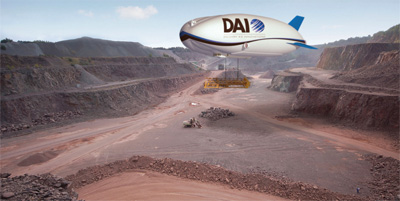 Ice roads and railroads are still the preferred means of transportation for existing and proposed mines in Ontario’s swampy James Bay Lowlands, but two innovative transportation solutions are being touted as greener and less disruptive to fragile natural habitats.
Ice roads and railroads are still the preferred means of transportation for existing and proposed mines in Ontario’s swampy James Bay Lowlands, but two innovative transportation solutions are being touted as greener and less disruptive to fragile natural habitats.
Discovery Air Innovations, a Canadian company, has an agreement with U.K.-based Hybrid Air Vehicles to introduce the HAV366 airship as a transportation solution for “the Canadian Arctic or wherever transportation infrastructure does not exist.”The HAV366 is the 50 tonne model of a family of hybrid air vehicles ranging in payload capacity up to 200 tonnes.The airship is the size of a football field and has a cargo area measuring 30 metres long, five metres wide and four metres high with roll-on, roll-off capability and overhead cranes and winches to facilitate loading and unloading. Top speed is 130 kilometers per hour.A combination of helium, areodynamic design and vectored thrust from four 2,400 horsepower turbine engines provide lift and propulsion.
It operates on a “point to point basis” without a requirement for an airport, runway or any special infrastructure at either end, said Discovery Air Innovations director of business development Stephen Newton. Retractable hover skirts on the underside of the two outer hulls allow the craft to land on water, muskeg, ice, snow, or gravel.
The HAV366 carries a 50-tonne payload and could be ready for service with all of the required certifications by late 2014. A 200-tonne version could take until 2017, said Newton, while an airship with a 1,000-tonne payload capability “is a completely different engineering challenge” and probably won’t be a reality until 2020, he speculated.
With global warming shortening the ice road season in Northern Canada, mining companies will face some big decisions, warned Newton. “They can either start building roads which can cost $1 million per kilometer, or they can use heavy lift air vehicles to get supplies in and out.
But building a road or a railway “can take years and millions of dollars just to get environmental approval and, if you’re dealing with a sensitive area, you may not even get it, in which case you have a stranded resource.”
Yet another transportation solution targeting the resource sector is the so-called hoverbarge from Hovertrans Solutions Pte. of Singapore.
The hoverbarge is designed to carry payloads of up to 2,500 tonnes on a cushion of air and can travel over ice, snow and flat swampy terrain. Hoverbarges are designed to be self-propelled, but the larger 2,500-tonne model would have to be towed by a second, smaller hoverbarge, said Stuart Turner, regional director of business development. The self-propelled barges travel at a speed of up to nine kilometres per hour.
Two hoverbarges are currently in service in Surinam and a new unit built by ST Marine of Singapore became available for charter in October. This newest vessel measures 34 metres long by 17 metres wide, carries a 50-tonne payload and is built using a modular design, allowing it to be disassembled and shipped economically via conventional container vessels to a project site.
The hoverbarge is constructed of steel, operates in temperatures as low as minus 40 degrees Celsius and exerts one pound per square inch ground pressure on hover, minimizing environmental impact.
One of the advantages of a hoverbarge over ice road travel, said Turner, is that a hoverbarge can take a shorter, direct route to a project site and isn’t restricted to a specific route dictated by the topographical requirements of ice road construction.
www.da-innovations.com
www.hovertranssolutions.com


